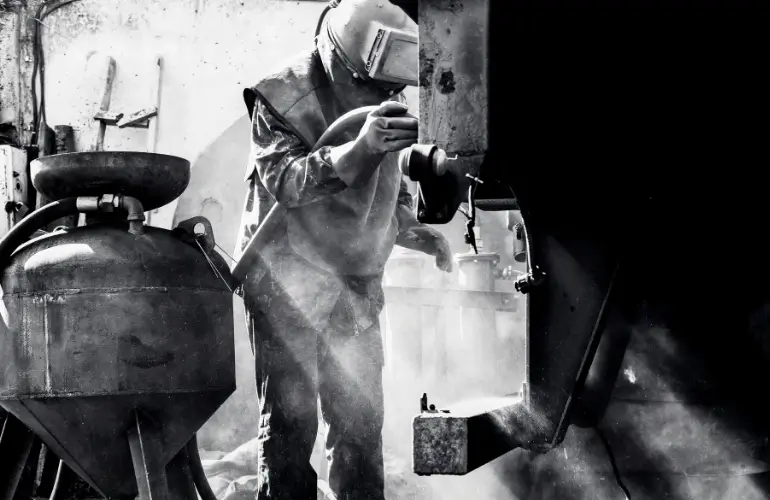Etching and Sandblasting (Shot Blasting)
Sandblasting (shot blasting) is a process that involves cleaning or shaping any surface using an abrasive material in a stream of compressed air.
The effect of shot blasting is similar to grinding; however, the cleaned surface is smoother and achieves the roughness required for painting. Additionally, it avoids problems associated with cleaning hard-to-reach corners or curves.
Sandblasting is the most effective method for surface cleaning – removing rust and old paint coatings. However, it can also pose the risk of irreversible damage to the cleaned surface, which is why we approach each order individually and with the utmost care for the entrusted material.

Our shot blasting chambers are designed for pneumatic cleaning of steel objects and welded structures using stream-abrasive processing. Our shot blasting chambers are equipped with high-quality modern equipment.
The objects are cleaned by a worker who is inside the shot blasting chamber during the process.
Sandblasting has many advantages. It is an eco-friendly method – during sandblasting, aggressive, corrosive substances are not used as in chemical cleaning. Sandblasting provides excellent results, and the paints or varnishes used adhere perfectly to the roughened surface. During this process, the substrate does not absorb water – unlike high-pressure washing, which can cause salt deposits. We perform sandblasting of sheets, among other things.
Types of Abrasive Materials Used in Sandblasting
Various abrasive materials are used in the sandblasting process, which affects the efficiency and quality of the work. The choice of the appropriate material depends on the type of surface and the client's requirements. The most popular abrasive materials include:
- Quartz Sand – commonly used due to its hardness and availability. Suitable for removing rust, paint, or contaminants from metal surfaces.
- Glass Beads – gentler than quartz sand, ideal for cleaning glass, plastic, and ceramic surfaces.
- Steel Shot – primarily used in the metal industry for cleaning steel structures and cast iron parts.
- Tungsten Carbide – very hard and wear-resistant, used for processing stainless steel surfaces, metal alloys, or stone.
Comparison of Sandblasting with Other Surface Cleaning Methods
Compared to other surface cleaning techniques, such as high-pressure washing or chemical cleaning, sandblasting has its advantages and disadvantages.
Advantages of Sandblasting:
- Effectiveness – quickly and efficiently removes rust, paint, and contaminants.
- Eco-friendliness – does not use corrosive chemical substances.
- Good surface preparation for painting – the obtained roughness improves the adhesion of paints and varnishes.
However, sandblasting also has its drawbacks. Primarily, there is a risk of damaging the surface material during shot blasting. Incorrect selection of abrasive material can lead to irreversible damage. Sandblasting is also associated with high noise levels. Sandblasting work generates significant noise intensity, necessitating the use of personal protective equipment.

